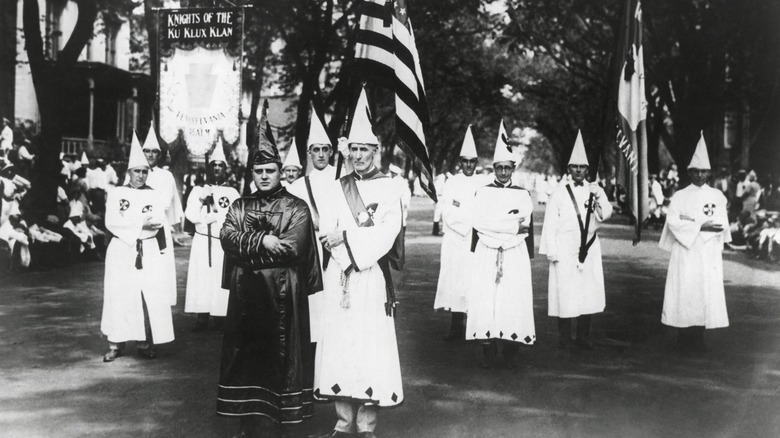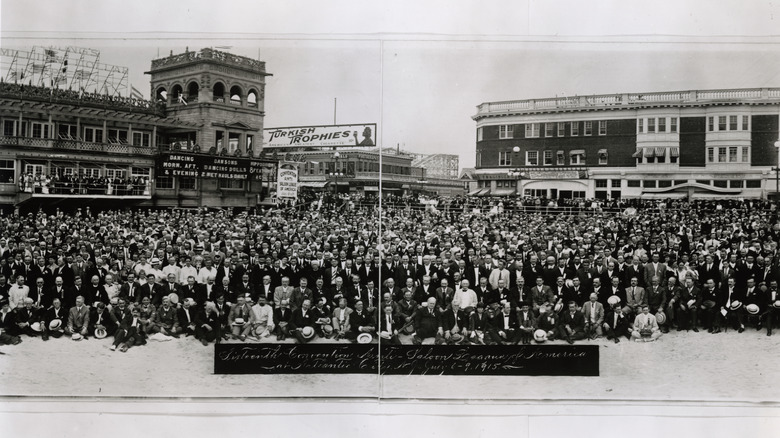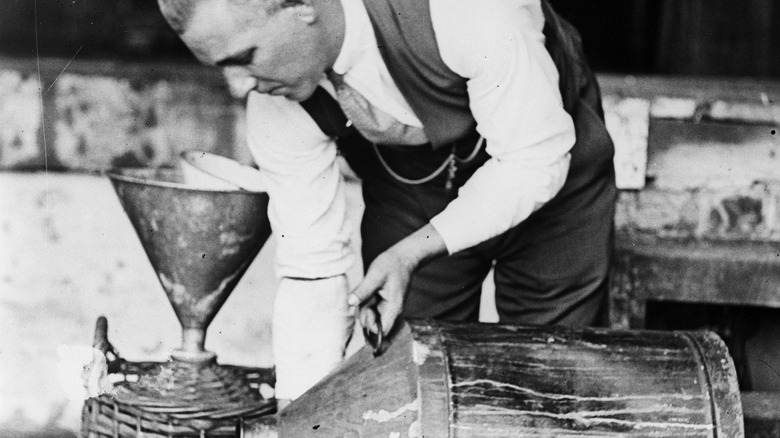Why The KKK's Reign Of Terror Soared During The Prohibition
The members of the Klu Klux Klan under the leadership of a former federal prohibition agent, kicked down doors in private homes, looted, beat, and arrested the occupants all in the name of enforcing the law. It was January 1924 in "Bloody" Williamson County, Illinois and the KKK had joined forces with S. Glenn Young, an ex-federal agent who'd been fired for his penchant for violence, with the stated goal of stopping the sale and manufacture of alcohol that the 21st Amendment had made illegal, per NBC Chicago. Their true goal was to terrorize the Catholic residents of the county. But an anti-Klan organization, the Knights of the Flaming Circle, sprang up to protect residents from the KKK, according to the Associated Press and The New York Times.
Pitched battles soon raged, necessitating the county sheriff to request National Guard troops to come in and quell the violence. This wasn't a one-off as far as the KKK and Prohibition. The racist terrorist organization saw the 21st Amendment as a way to grow its membership across the United States as part of its campaign against anything it felt didn't represent white Protestant nationalist "values," according to "One Hundred Percent American: The Rebirth and Decline of the Ku Klux Klan in the 1920s." Among its targets were Blacks, Jews, immigrants, especially Catholics, along with bootleggers and progressive women.
The Anti-Saloon League and the KKK
The powerful Anti-Saloon League, one of the major organizations that helped make Prohibition the law of the land, blamed immigrants, mostly from heavily Catholic countries in Southern Europe, for the scourge of alcohol, according to History. Beyond its anti-immigrant slant, the organization had loose ties with the KKK, which helped the Klan gain followers. Among its ranks were many members of the KKK. "The father and mother of the Klu Klux is the Anti-Saloon League," the renowned lawyer Clarence Darrow remarked in 1924 (via "The Second Coming of the KKK: The Ku Klux Klan of the 1920s and the American Political Tradition”). "I would not say every Anti-Saloon Leaguer is a Ku Kluxer, but every Ku Kluxer is an Anti-Saloon Leaguer."
The two organizations were gathering members from the same demographic, typically white middle-class, evangelical Protestants from rural areas, per "The Second Coming of the KKK." Prohibition was a good cover for the KKK's true motives. "This issue was used instrumentally as a mandate to target those groups they already saw as enemies of white Protestant nationalism: immigrants, Catholics, and African Americans," author, historian, and professor Lisa McGirr told Slate.
Promises to fight bootleggers
The KKK's ranks swelled during the first decade of Prohibition to between 2 and 5 million members from 1920 to 1925, with its promise to rid communities of lawlessness associated with illegal alcohol, according to Slate. "The Klan often gained a foothold in local communities in the 1920s by arguing that it would clean up communities, it would get rid of bootleggers and moonshiners," Lisa McGirr told History.
But by the early 1930s, the Klan was in decline due in part to the lawlessness they demonstrated in Williamson County, Indiana in 1924 and the murder conviction of David Curtis Stephenson, the grand dragon of the Indiana KKK, for the death of his girlfriend Madge Oberholtzer the following year, per a report by the Illinois General Assembly and the Virginia Commonwealth University Libraries. The Anti-Saloon League likewise suffered in part because of its association with the KKK, even before the Great Depression turned public sentiment against Prohibition. During a June 1924 meeting in South Carolina, when the Baptist preacher and head of the local Anti-Saloon League espoused Klan rhetoric, the crowd turned against him and walked out, per "Hoodwinked: The Anti-Saloon League and the Ku Klux Klan in 1920s Prohibition Enforcement."


